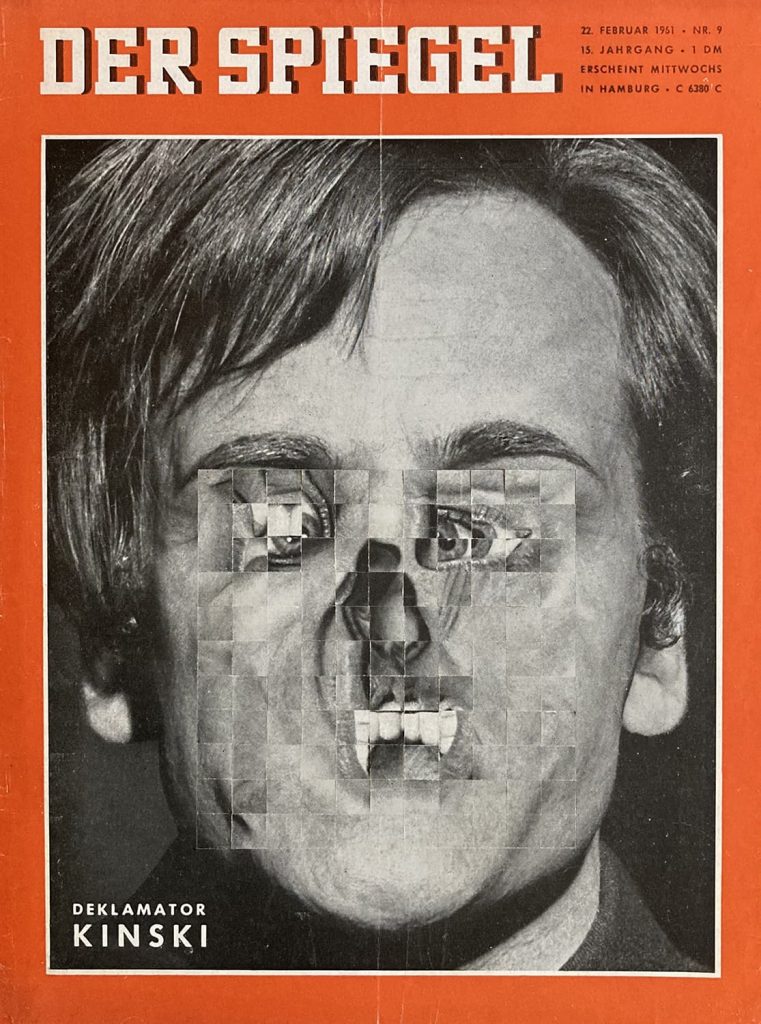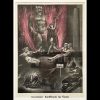TWS –Please tell us something that you’d like our readers to know about you.
SA –The decision to publish my art under a pseudonym is direct expression of my deep conviction, that the work itself should be the exclusive focus of art. Though the artist’s vita might in some very few cases (eg. Joseph Beuys or Frida Kahlo) help to understand the respective oeuvre, it too often degenerates into an interfering white noise: a media-effective sales story, that distracts the attention of the viewers and sooner or later of the artists themselves. In my eyes, the unmistakable quality mark of really good art is not to need any additional explanations or background information.
So drawing a clear-cut line between “art” and “marketing” reflects how I like to create my art and how I’d like my works to be seen. Not as a business vehicle, but as a creative and totally self-sufficient form of personal expression. This doesn’t mean to be completely speechless or invisible, take this interview as proof of the opposite: It’s rather about staying in the background and letting the works take the show room …
By-the way: Internet in general and particularly the social platforms – the alleged driver for democratizing art – actually accelerate this shift from substantial to commercial art: geared to conformism and mainstream, designed and marketed like a consumer product, created and consumed like fast food. But I guess, that’s a different topic …


TWS –What is the place of art in your life? What drew you to collage?
SA –I grew up with vinyl record cover artwork (e.g. Dead Kennedys, Sonic Youth, Black Flag, …), that in retrospect most probably not only preformed my general understanding of art’s purpose, but also subconsciously influenced my personal compositional style. Hence, it’s for example no coincidence that all my works to this day have rectangular shapes – made to potentially end up as record cover.
I am totally addicted to all kinds of visual and performing arts, literature and music. As long as they serve not as an uncritical accomplice, but as a thorn in the flesh; ideally in form and content. Being pleasing or entertaining is definitely not my thing and – in my opinion at least – misses the very purpose of art: to be stimulating and thought provoking.
In this regard, making art with nothing else but some old prints and a handful of physical tools fits perfectly: First of all, I’m absolutely independent and flexible – no need for a studio, expensive materials, state-of-the-art technology. And secondly, rearranging officially published images is the perfect way, to mirror modern’s society and human mankind’s abysses as unadulterated as possible. For me it’s not about coming up with pretty picture, but to continue the subversive, non-conformistic tradition of cubism, dadaism and surrealism in a contemporary form.
For me it’s not about coming up with pretty picture, but to continue the subversive, non-conformistic tradition of cubism, dadaism and surrealism in a contemporary form.

TWS –I can see traces of influences of artists like Jiri Kolar or Terry Gilliam, to name a few, but your work has a unique and personal style. Can you walk us through the influences that inform your work?
SA –Honestly I have to admit, that in my perception “collages“ never played a major or dedicated role, I’ve always been – and hopefully will be – always open for any kind of substantial art. Referring to my “vinyl education“ in the early days Winston Smith, Mike Kelly, Raymond Pettibon and Gottfried Helnwein have to be mentioned as influences for sure.
Accompanied by famous Renaissance painters such as Jan Van Eyck or Rogier van der Weyden, who impressively prove that almost every stylistic device required for an overwhelming composition was brought to perfection more than five centuries ago. And of course Francis Bacon, Joseph Beuys, Anselm Kiefer, Cindy Sherman, Mike Kelly, Gehard Demetz …
Starting to post my works on Instagram in May 2021 had a positive side effect, definitely closing some of my huge knowledge gaps and white spots: I explored the world of collage for the first time, also to discover the fact that many of my works have striking parallels with well-known artists (e.g. the aforementioned Jiri Kolar or John Stezaker) or with completely unknown artists somewhere at the other end of the planet.
But it is precisely at this point that another invaluable advantage of collage as an art form becomes apparent: it opens up an almost unlimited range of techniques, compositions and styles. A built-in guarantee to continuously develop your own style and perfect your individual signature without ever getting bored or – even worse – starting to bore others.


TWS –Most of your collages are portraits. What led you to have portraiture as the center of your practice?
SA –There are a number of answers to this question. First of all, it’s comparatively easy to find tons of material in usable quality and size. The second aspect relates to what I said earlier about art as a mirror of society and mankind: faces embody the perfect metaphor for me in this context. They also open up the unique possibility of completely changing expression and mood (and thus the context and message of the resulting work) with just a few changes – because the entire range from vulnerability to vulgarity lies dormant under the surface, just waiting to be awakened. It reminds of the frequently mentioned butterfly effect: a minimal change can produce a maximum distortion – a relationship that ultimately sums up the common leitmotif of all my work. And finally, faces are the symbol of “beauty” – irresistibly provoking me to challenge existing conventions and standards by confronting the audience with some other types of beauty.
TWS –”Transformation“ is an idea that you tend to gravitate to when describing your work. Can you expand on the notion of transformation in your work?
SA –Indeed, for me it’s all about transformation. The idea is based on the fundamental theory of “radical constructivism“; it says, that reality is per se no given, binding and normed space, but an individual construction made by the human brain(s). Hence, there are billions of particular drafts of “reality” and the “real world“. And like fingerprints, you’ll not find two similar ones. On the one side this is mankind’s huge strength, fostering creativity, progress & reflection; on the other side, it makes communication – between individuals as well as between systems or states – so difficult. So my transformations show in a very pointed way, how differently things can be seen; and that there is no single truth or the one and only reality.
This conceptual core is also the reason, why I use one or max. two original elements for each of my works: The process of the transformation, it’s quality and execution is at least as relevant as the final result. My “Broken Mirrors“ series builds the ultimate top in this regard, decomposing existing magazine cover into 418 squares as basic material for a different interpretation of the original context.
TWS –You work mostly with vintage images. What attracts you to these images? Do you think that your visual language can work as well with contemporary imagery?
SA –Again, it’s a combination of factors. In my eyes, their composition and colors are superior to all modern stuff, including the specific texture of the vintage paper. You really can sense, that these images were created manually. “Digital” was involved at no point, one could understand these magazine covers and even more the advertisements as archetypal collages. Hence, they secondly complete my ideal of “analog transformation”: on the basis of handmade originals, handmade originals are created. And finally, there’s also the self-discipline aspect to mention: In 99% of the cases I only have this one edition of the original – so literally no mistakes are allowed, every cut just needs to be thought out and executed to perfection. A circumstance that generates due respect, not to destroy the original and thus inevitably sharpens one’s own concentration massively …
Consequently, although the results are comparable or even more technically perfect due to the better quality of the paper, I miss the thrill of transformation when I work – very rarely – with contemporary images.
TWS –Can you walk us through the process of creating your pieces? Do you work in series or on individual artworks?


SA –As said, working with vintage originals definitely forces you to already have a quite clear idea about the transformational direction before making the first cut. The more geometric the technique/composition is, the less flexibility you have – I would guess that it’s up to 75% preparation and conceptualization vs. 25% of “doing“ in those cases. Nevertheless, there are plenty of works (take the series with “scattered“ faces for example) where the given conceptual frame even fosters your creativity, because it’s exactly this limitation of options that challenges you even more and leads to you surprising, unforeseen solutions.
Because they highlight the huge diversity of seemingly simple approaches, I really love to work in series. It’s always my ambition to show that the particular concept not only led to a single lucky shot, but to a number of very different, nevertheless consistently convincing works. And honestly, very often I’m discovering and exploiting a technique’s or a compositional idea’s full potential just in the course of the series (which makes stopping it and moving on to the next one quite a challenge). In addition as a whole, they definitely create a stronger impact than each work for itself. But at the same time, it makes it even more difficult to let single pieces go (in terms of: selling them), because it feels like tearing things apart, that definitely belong together. A kind of meta level collage …
… it’s exactly this limitation of options that challenges you even more and leads to you surprising, unforeseen solutions.
TWS –What is the most challenging aspect of your work?
SA –I only use manual techniques and tools – cutter, ruler, glue – for my work. At first sight they are only a possible means to an end to achieve a certain compositional effect. In fact, however, the quality and persuasiveness of the work depend fundamentally on the ability to master the process of cutting and gluing almost perfectly. In my opinion, the balance between technical and compositional dimensions is the greatest challenge on the way to a – at least partially – satisfactory work. Following this path won’t eliminate the usual doubts that you could have done better – but it will minimize the risk of ending up in either technical overkill on the one hand or creative chaos on the other. The old dilemma between Scylla and Charybdis …
This dual challenge is something, that I’d personally miss in digital art. Without any doubts, modern technique creates – or better: supports to create – great artworks, sometimes you can’t even tell wether it’s analog or digital. I am pursuing the opposite direction: while artificial intelligence is becoming more and more sophisticated I am trying to imitate the technical perfection of digital creations with purely physical possibilities. The analog empire strikes back …
Learn more about Stratco Artist on his Instagram account.














